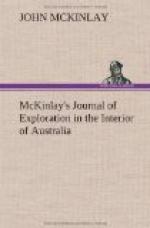taken. Description of body, skull, etc: marked
with slight sabre cuts, apparently two in number,
one immediately over the left eye, the other on the
right temple, inclining over right ear, more deep than
the left. Decayed teeth existed on both sides
of lower jaw and right of upper; the other teeth were
entire and sound. In the lower jaw were two teeth,
one on each side (four between in front) rather projecting
as is sometimes called in the upper jaw buck teeth.
I have measured the bones of the thigh and leg, as
well as the arm, with a cord, not having any other
method of doing it. Gathered all the bones together
and buried them again, cutting a lot of boughs and
other wood, and putting over top of the earth.
Body lies with head south, feet north, lying on face,
head severed from body. On a small tree, immediately
south, we marked MK Oct. 21, ’61. Immediately
this was over we questioned the native further on
the subject of his death. He says he was killed
by a stroke from what the natives use as a sword (an
instrument of semicircular form) five to eight feet
long and very formidable. He showed us where the
whites had been in camp when attacked. We saw
lots of fish bones but no evidence then on the trees
to suppose whites had been there. They had certainly
chosen a very bad camp in the centre of a box scrub
with native huts within 150 to 200 yards of them.
On further examination we found the dung of camels
and horse or horses, evidently tied up a long time
ago. Between that and the grave we found another
grave, evidently dug with a spade or shovel, and a
lot of human hair of two colours, that had become decomposed,
on the skin of the skull, and fallen off in flakes—some
of which I have also taken. I fancy they must
all have been murdered here; dug out the new-formed
grave with a stick (the only instrument we had) but
found no remains of bodies save one little bone.
The black accounted for this in this manner, he says
they had eaten them. Found in an old fireplace
immediately adjoining what appeared to be bones very
well burned, but not in any quantity. In and
about the last grave named a piece of light blue tweed
and fragments of paper and small pieces of a Nautical
Almanac were found, and an exploded Eley’s cartridge.
No appearance on any of the trees of bullet marks
as if a struggle had taken place. On a further
examination of the blacks’ camp where the pint
pot was found there was also found a tin canteen,
similar to what is used for keeping naphtha in, or
some such stuff, both of which we keep. The native
says that any memos the whites had are back on the
last camp we were at on the lake, with the natives,
as well as the ironwork of saddles which on our return
we mean to endeavour to recover if the blacks can
be found; it may be rash but there is necessity for
it. I intend before returning to have a further
search. No natives yet seen here.
Tuesday, October 22.




